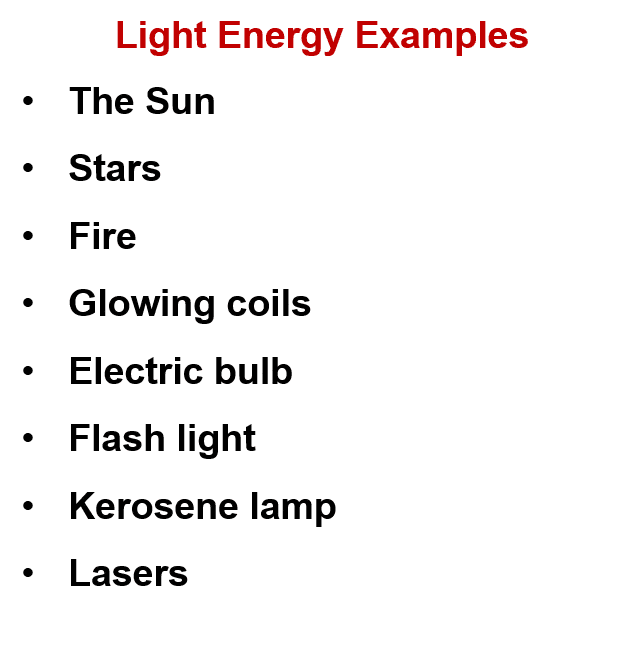Light energy is a form of energy that moves as transverse waves with a wavelength of 400–700 nanometers and is visible to the naked eye. Hot objects such as lasers, lamps, and the sun produce an electric pulse, which is called light.
Photons are tiny energy packets that make up light.
Keep reading to learn more about light energy sources, types, examples, and the relationship between wavelength and frequency of light energy.

Table of Contents
Light Energy in Simple Words
The sun produces an enormous amount of electromagnetic radiation (solar energy).
Only a small amount of this energy is visible to humans and is called visible light energy.
Light always travels in a straight line and can be seen through the naked eye at a particular wavelength.
It is made up of small packets of energy called photons.
Light travels at a rapid speed; in fact, nothing travels faster than light. Its speed is approximately 300,000 km per second. Some examples of light energy are light from stars, fire, the sun, glowing coils, electric bulbs, flashlights, lasers, and light from kerosene lamps.
Photons
Light is mostly made up of photons, which are tiny particles.
Photons are bundles of energy that are created when the atoms of an object heat up.
They have no mass and bear a set amount of energy.
Types Of Light Energy
- Visible light is the only type of light that can be seen by the naked eye. It is in the electromagnetic energy form. The sun is its most common source, but it can also be released by lanterns, flashlights, and light bulbs.
- Infrared Light: Another form of electromagnetic energy that emits heat is infrared light. Since infrared waves move from our remote to the TV, it is used to switch on your television with a remote.
- X-rays and ultraviolet light: These are brief light waves that doctors use to photograph our bodies in order to detect cracks in our bones. X-rays are used by dentists to determine the extent of tooth decay.
Examples of Light Energy

- Sunlight
- Laser light
- A glowing bulb produces light
- Light-emitting from a kerosene lamp
- Stars and other luminous bodies emit light.
Key Points
- Light is a form of electromagnetic radiation that can be seen by the human eye.
- The Sun is the closest star to the planet Earth and radiates light energy.
- Photons are the particles that light is made up of, which are like tiny packets of energy.
- Light has two types of nature. It can act as a particle and also as a wave.
- The exact speed of light in a vacuum is 299,792 kilometers per second.
- The rate at which light is emitted by the source is called the intensity of light.
- The intensity of light is the rate at which light is emitted on a unit of surface or energy per unit of time per unit of area or brightness.
- The number of crests that pass through a specific point in a second is known as light frequency.
- The distance between two consecutive crests or troughs is known as the wavelength of light.
- Light waves travel at the same speed in a vacuum.
- The wavelength and frequency are related in that the higher the frequency, the shorter the wavelength.
- Unpolarized light is described as light waves that vibrate in more than one plane.
- Unpolarized light is converted to polarized light by the mechanism of polarization.
- “Phase” refers to a specific point in the cyclic waveform’s time cycle. When the waves are in phase, the strength of light increases.
Light Energy Units
- Light energy is measured in electron volts (eV).
- The wavelength of light λ is measured in both angstroms and nanometers.
- The frequency of light is measured in Hertz.
Transverse Waves
When all points on a wave oscillate along paths perpendicular to the wave’s advancing direction, this is referred to as transverse wave motion. Water surface ripples, seismic S (secondary) waves, and electromagnetic (e.g., radio and light) waves are all examples of transverse waves.
The equation v = fλ describes the propagation speed of a transverse wave and is called the transverse wave equation. The wave’s motion is perpendicular to the direction of energy transmission.
In the above equation, f is the frequency of the wave and λ is the wavelength.
Bottom Line
This article focuses on the definition of light energy and the physical characteristics of light. We hope that after reading this article you are able to describe the nature and properties of light. If you have any questions, please feel free to comment.
Related Links
Room Temperature| Comfortable Temperature
Mechanical Energy| 7 Daily Life Examples
Can Force be Negative?
Kinetic Energy Formula
Velocity Formula & Definition
Momentum Equation| Definition and Examples
Frequently Asked Questions (FAQs)
1. What is malus law?
According to Malus’ law, the intensity of plane-polarized light passing through a polarizer is proportional to the square of the cosine of the angle formed between the analyzer’s transmission axis and the polarizer.
It is a visible part of the electromagnetic spectrum. It is radiant energy that travels in a straight line and can be seen with the naked eye at a specific wavelength.
Temperature is not a form of energy. It is the degree or intensity of heat present in a substance or object.
Photon energy is given by E = hf and is related to the frequency f and wavelength λ of the radiation by
E=hf=hcλ(energy of a photon).
where E is the energy of a single photon and c is the speed of light.
h is Planck’s constant and its value is 4.14 × 10−15 eV · s.
More Interesting Links
Heat Flux-An Overview
Arrhenius Equation Definition & Formula
Instantaneous Velocity| Easy Key Points
Dynamic Viscosity-An Overview
Longitudinal Waves| Physics
What is a Jamboard| The Definitive Guide
- BCl3 Lewis Structure in four simple steps - November 1, 2023
- PH3 Lewis Structure in four simple steps - October 8, 2023
- PF3 Lewis structure in four simple steps - September 24, 2023



